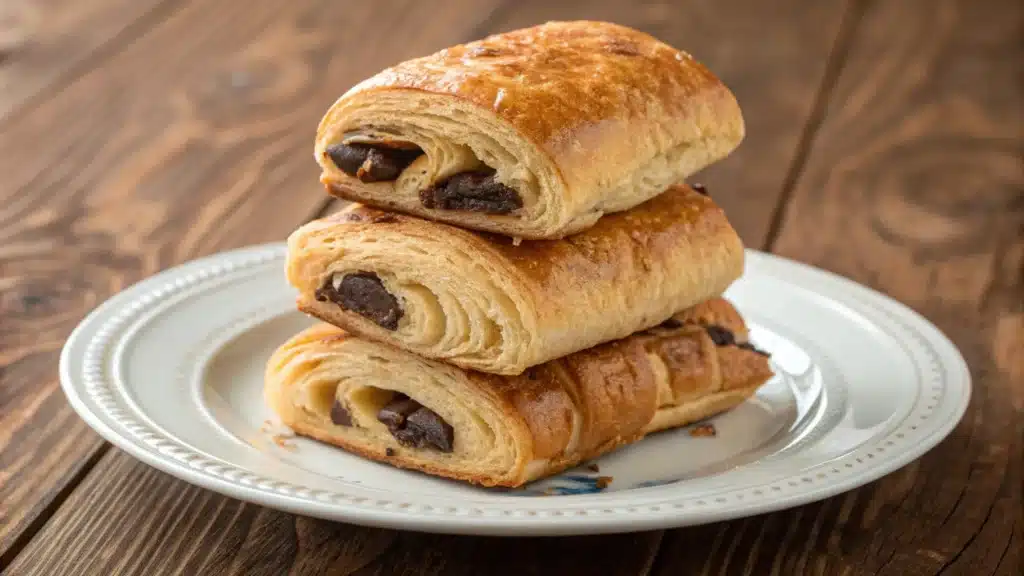Have you ever strolled through a bakery and found yourself staring at a beautifully golden croissant, only to notice a similar pastry called a Gipfeli sitting nearby? You’re not alone! These two treats, while seemingly alike, each bring their own charm to the table. In this article, we’ll uncover what is the difference between a croissant and a Gipfeli by diving into their origins, preparation techniques, cultural significance, and even their nutritional profiles. By the end, you’ll know exactly which pastry to pick for your next breakfast or snack.
Table of Contents
Introduction to Croissants and Gipfeli
What are Croissants?
The croissant is a classic French pastry that has become a global icon. With its crescent shape, flaky layers, and buttery goodness, it’s hard to resist this delectable treat. But did you know its origins trace back to Austria? The croissant evolved from the Viennese kipferl, a crescent shaped bread, before becoming the French marvel we know today. The secret to its flaky layers lies in laminated dough, which involves folding butter into the dough multiple times.
Croissants are often enjoyed plain or filled with sweet or savory delights like chocolate, almonds, or ham and cheese. Their versatility makes them a beloved choice for breakfasts, brunches, and everything in between.
What are Gipfeli?
Now, let’s travel to Switzerland, the homeland of the Gipfeli. Often referred to as the Swiss cousin of the croissant, the Gipfeli shares the crescent shape but differs significantly in texture and taste. Unlike croissants, Gipfeli are typically denser and less buttery, making them a less flaky, more bread-like option.
Gipfeli also come in both sweet and savory varieties, but they tend to be simpler in flavor compared to croissants. For Swiss locals, a Gipfeli is a breakfast staple, often paired with coffee or tea. It represents a harmonious blend of convenience and tradition in Swiss baking.
Key Differences Between a Croissant and a Gipfeli
Origins and Cultural Significance: What Sets Croissants and Gipfeli Apart?
When exploring what is the difference between a croissant and a gipfeli, it’s essential to start with their origins. Croissants hail from France but were inspired by Austria’s kipferl, a crescent shaped bread enjoyed as early as the 13th century. Over time, French bakers refined the recipe into the rich, buttery pastry we recognize today. The croissant’s rise to fame symbolizes French culinary finesse and has made it a breakfast staple worldwide.
In contrast, Gipfeli represent Switzerland’s version of the crescent-shaped pastry, combining Swiss baking traditions with a focus on simplicity. While croissants are seen as symbols of indulgence, Gipfeli are more practical. They are a breakfast staple in Switzerland, loved for their straightforward flavor and texture, which go perfectly with a spread of butter or jam.
Ingredients and Preparation: How Croissants and Gipfeli Differ
The key to understanding what is the difference between a croissant and a gipfeli lies in the ingredients and how they’re made. Croissants rely on laminated dough, a meticulous process of layering butter and dough to create the iconic flaky texture. French recipes emphasize high butter content, which Improves the croissant’s rich flavor.
Gipfeli, on the other hand, are made with less butter and often use milk or other fats to create a denser, less flaky texture. The dough is typically rolled and shaped differently, resulting in a firmer bite compared to the delicate layers of a croissant. While both pastries use yeast, croissants often undergo a longer proofing time, adding to their lightness.
Texture and Taste: Comparing Croissants and Gipfeli
One key difference is texture. Croissants are known for their light, flaky layers that almost melt in your mouth. Gipfeli, on the other hand, have a firmer, more bread like texture with a bit of chewiness. This small difference makes croissants seem richer and more luxurious, while Gipfeli feel simpler and more adaptable.
Taste also sets them apart. Croissants are intensely buttery, with a slightly sweet or savory edge depending on the filling. Gipfeli have a milder flavor, allowing accompaniments like jam or honey to shine. This makes Gipfeli a practical choice for those who prefer a less buttery alternative.
Shape and Appearance: Croissants vs. Gipfeli
Although both pastries share the crescent shape, the details differ. Croissants have a more pronounced curve and are often slightly larger with visible layers from the laminated dough. Gipfeli are less curved, more compact, and smoother in appearance, reflecting their denser interior. This difference in shape can be a quick visual cue when distinguishing the two.
Why Do Croissants and Gipfeli Matter?
Cultural Identity in Baking: Croissants and Gipfeli’s Unique Roles
Baking traditions are key to preserving cultural identity, and the difference between a croissant and a Gipfeli becomes even more meaningful in this context. Croissants represent French baking at its finest, known for their careful preparation and rich flavor. They are a symbol of indulgence, often tied to relaxed mornings and the charm of Parisian cafés.
In Switzerland, the Gipfeli is more than just a pastry; it’s a morning ritual. Its modest design and balanced flavor mirror Swiss values of practicality and tradition. For many, sharing a Gipfeli over coffee is a simple pleasure that connects generations.
Global Popularity: How Croissants and Gipfeli Appeal Worldwide
Both croissants and Gipfeli have gained popularity far beyond their origins. Croissants are a global phenomenon, often found in high end bakeries and chain cafés alike. They’ve inspired countless variations, from almond croissants to the hybrid cronut.
Gipfeli, though less known worldwide, are a beloved favorite in Swiss homes. Found easily in supermarkets and bakeries across Switzerland, they reflect both their convenience and lasting popularity. These pastries, alongside croissants, show the shared love for baked goods while honoring their distinct cultural origins.
Health and Nutritional Comparisons
Calorie Content: What is the Difference Between a Croissant and a Gipfeli?
When discussing what is the difference between a croissant and a gipfeli, nutrition is a key consideration. Croissants, with their high butter content and flaky layers, tend to pack more calories and fat per serving. A standard croissant contains about 250-300 calories, depending on its size and whether it includes fillings like chocolate or almond cream.
Gipfeli, in contrast, are generally lower in calories. They use less butter and may include milk or margarine, making them a lighter choice. A plain Gipfeli usually has about 200-250 calories, which makes it a good option for calorie conscious individuals.
Both pastries provide energy from carbohydrates, but croissants lean heavily on fat for their rich flavor. For those looking for lower fat alternatives, the Gipfeli’s simpler recipe could be the better pick.
Dietary Trends: Are Croissants or Gipfeli Better for You?
In today’s world of varied dietary needs, both croissants and Gipfeli can be customized to suit different preferences. Croissants now come in whole grain, vegan, and gluten free versions. Similarly, Gipfeli are often available in whole grain or plant based options, making them accessible to a wider range of diets.
Croissants often lead in innovation, with unique fillings and shapes that embrace food trends. Gipfeli, by contrast, stay true to their classic simplicity, appealing to those who prefer traditional flavors without extra flair.
For more delicious baking ideas, check out our recipe :
How to Choose Between a Croissant and a Gipfeli?
When to Choose a Croissant
If you’re in the mood for indulgence, the croissant is the perfect choice. Its buttery, flaky layers pair beautifully with coffee or tea, making it ideal for a relaxed breakfast or a rich snack. Croissants also shine at special occasions like brunches or celebratory meals, thanks to their elegant texture and appearance.
If you enjoy variety, croissants offer endless possibilities. From savory fillings like ham and cheese to sweet delights like chocolate or almond cream, there’s a croissant for every mood. Their delicate texture makes them a treat that’s hard to resist.

When to Opt for a Gipfeli
On the other hand, the Gipfeli is ideal for those who prefer a no-fuss option. Its denser texture and milder flavor make it perfect for pairing with spreads like butter, jam, or honey. Whether you’re on the go or enjoying a simple breakfast at home, Gipfeli provide a comforting and satisfying choice.
For health conscious individuals, Gipfeli might be a better fit. They’re generally lower in fat and calories, which can align well with lighter eating habits. Plus, their firmer texture holds up better for dipping into coffee or tea, a common tradition in Swiss households.

FAQs
What is the Difference Between a Croissant and a Gipfeli in Origins?
The word “croissant” is derived from the French word for “crescent,” highlighting its signature crescent shape. Though closely tied to French cuisine, croissants actually trace their origins to Austria’s kipferl. Over the years, French bakers refined this humble bread into the rich, flaky delight we know today, adding an intriguing layer to the question of what is the difference between a croissant and a gipfeli.
Are Gipfeli Healthier Than Croissants?
Gipfeli are often considered a healthier option compared to croissants. With less butter and fewer calories, Gipfeli cater to those seeking a lighter breakfast or snack. While both pastries have their place in a balanced diet, choosing a Gipfeli can be a practical option for calorie conscious eaters. However, moderation is key with either choice, especially when paired with rich spreads or fillings.
Why are Croissants Flakier Than Gipfeli?
The secret to the croissant’s flakiness lies in its laminated dough. This technique involves folding butter into the dough multiple times, creating thin, delicate layers. Gipfeli, however, use less butter and a simpler dough, resulting in a firmer, less flaky texture. This difference in preparation highlights a key aspect of what is the difference between a croissant and a gipfeli.
What Makes Swiss Gipfeli Unique?
Gipfeli are unmistakably Swiss, reflecting the country’s emphasis on tradition and practicality. Unlike croissants, Gipfeli embrace simplicity over indulgence. Their dense texture and subtle flavor make them a cherished choice at Swiss breakfast tables, offering a satisfying yet modest treat that pairs wonderfully with coffee or a spread of jam.
What’s the difference between croissants and sourdough croissants?
The difference between croissants and sourdough croissants is in how they rise. Regular croissants use yeast to create their light, flaky texture and buttery taste. Sourdough croissants use a natural starter, which takes longer to rise and gives them a tangy, rich flavor. This process often makes sourdough croissants slightly denser. Both are made with layered dough and butter, but sourdough croissants stand out for their unique taste and artisan appeal.
Conclusion: The Tale of Two Pastries
A Summary of What is the Difference Between a Croissant and a Gipfeli
By now, you’ve discovered the unique details of what is the difference between a croissant and a gipfeli. Both pastries share a crescent shape and rich history, yet they’re quite different. Croissants are light, flaky, and rich, representing French culinary art. Meanwhile, Gipfeli, with their firm texture and mild flavor, reflect Swiss tradition and simplicity.
Each pastry has its own charm, appealing to different tastes and occasions. Whether you enjoy the rich, buttery layers of a croissant or the simple, satisfying texture of a Gipfeli, both carry a piece of cultural and culinary heritage that makes them special.
Celebrating Pastry Diversity
In a world filled with diverse flavors and traditions, pastries like croissants and Gipfeli remind us of the joy found in variety. They invite us to appreciate the artistry of baking while embracing the cultures they represent. So, the next time you’re at a bakery, why not enjoy the best of both worlds? Your taste buds will thank you!
This wraps up our look at what is the difference between a croissant and a gipfeli. These two pastries may look alike, but their taste, texture, and history set them apart. Knowing what is the difference between a croissant and a gipfeli helps us enjoy them even more. Whether you pick the rich croissant or the simple Gipfeli, both are delicious treats with their own story.


